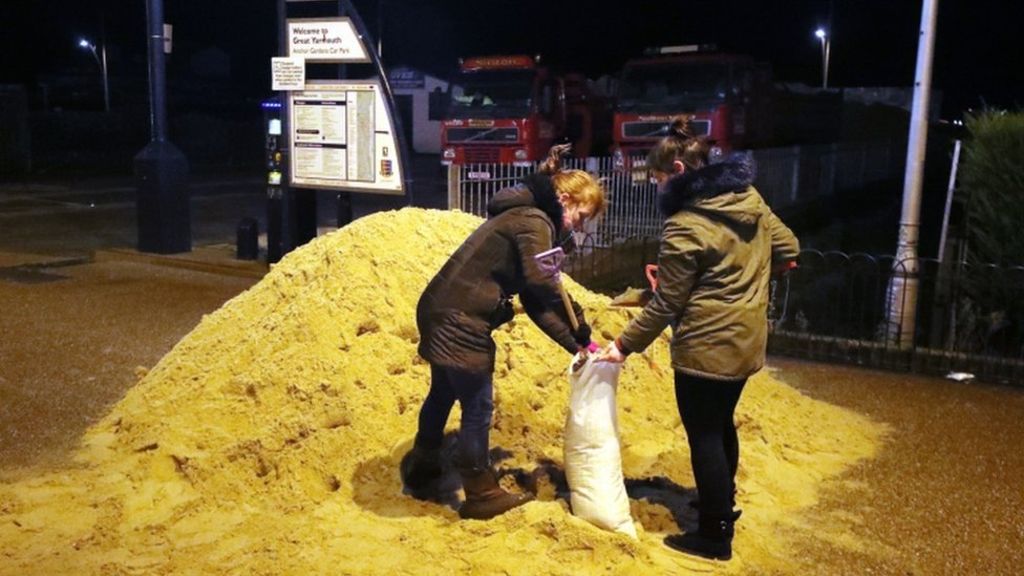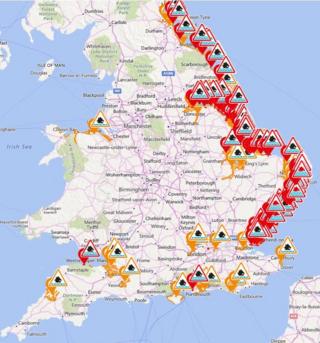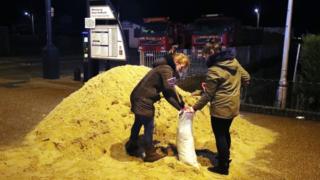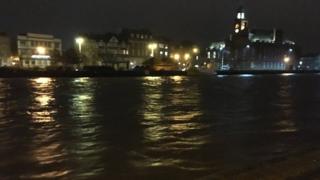Or use the form below
Tidal surge threat as snow and heavy winds grip UK – BBC News

People along England’s east coast are bracing themselves for a storm surge and the possibility of severe flooding.
The Environment Agency has issued 17 warnings of danger to life – with homes in Norfolk, Suffolk and Essex most under threat from high tides.
Thousands of people have been evacuated from their homes.
But in Great Yarmouth, where police have knocked on an estimated 15,000 residents’ doors, most have refused to leave.
Elsewhere, there are more than 80 flood warnings – meaning immediate action is required – and more than 70 flood alerts in place.
The Environment Agency has installed more than five miles (8km) of temporary barriers and sent 25 pumps to depots and towns along the east coast.
- Latest updates on winter weather
- Share your pictures, videos and experiences via haveyoursay@bbc.co.uk
The government’s flood information service has predicted that gale force winds will cause large waves, resulting in “potential damage to flood defences and flooding of property”.
The tidal surge passed without incident in Skegness, Lincolnshire, and waters levels are dropping in other areas including Boston, Lincolnshire, and Withernsea, Yorkshire.
Evacuate ‘immediately’
But there are still fears of widespread flooding further south, with Essex Police urging residents in Jaywick, Mistley and West Mersea, near Clacton-on-Sea, to leave their homes “immediately”.
By early evening, an educational centre in Tendring, Essex – which had been set up to cater for those evacuated from Jaywick – had registered about 140 of its residents.
 Image copyright Environment Agency
Image copyright Environment Agency  Image copyright Getty Images
Image copyright Getty Images Officials say about 2,500 homes and properties in the county could be affected by flooding, with the evening high tide expected there at around midnight.
Leaflets were delivered to homes warning people that their properties “could be flooded by sea water up to a depth of three metres”.
 Image copyright Getty Images
Image copyright Getty Images Nigel Brown, from Tendring Council, said there was room for 1,000 people and said they were ready for the next high tide at about 23:00 GMT.
Residents in approximately 5,000 properties near Great Yarmouth, in Norfolk have also been told to leave their homes.
 Image copyright PA
Image copyright PA BBC News correspondent Alex Dunlop said police in Great Yarmouth knocked on 5,000 doors, home to about 15,000 people, to try to persuade them to evacuate.
About 60-70% refused and insisted on staying, our correspondent said, though some may be making their own arrangements to leave.
About 80 people have also been evacuated from the Norfolk village of Walcott.

About 1,880 properties are also thought to be at high risk of flooding in Suffolk.
About 30 properties in the East Riding of Yorkshire have been evacuate amid fears they could be flooded.
Weather disruption across the UK:
- Up to 7in (18cm) of snow has fallen in Scotland, with warnings of high wind on the Skye, Dornoch and Kessock road bridges in the Highlands
- Eurostar cancelled two trains between London and Paris due to “weather conditions” in south-east England and northern France
- How cold is it where you are?
- Icy storm lashes France and Germany
Floods minister Therese Coffey said people needed to take the tidal surge seriously.
“I want to encourage people to respond to the calls for people, where they are at risk, to stay with friends or family or at rest centres.”
Earlier, snow, ice and winds caused travel problems across the UK, with the Met Office warnings of high winds, snow and ice on Friday. There are yellow warnings of ice in place across the UK for the rest of Friday and Saturday.
What is a storm surge?
A storm surge is a change in sea level that is caused by a storm.
The main cause of a storm surge is high winds pushing the sea water towards the coast, causing it to pile up there.
The strong winds in the storm generate large waves on top of the surge which can cause damage to sea defences, or spill over the top adding to the flood risk.
Source: Met Office
Do you live in regions affected by the adverse weather? Let us know about your experiences. Email haveyoursay@bbc.co.uk with your stories.
Please include a contact number if you are willing to speak to a BBC journalist. You can also contact us in the following ways:
- WhatsApp: +44 7525 900971
- Send pictures/video to yourpics@bbc.co.uk
- Upload your pictures / video here
- Tweet: @BBC_HaveYourSay
- Send an SMS or MMS to 61124 or +44 7624 800 100
Read more: http://www.bbc.co.uk/news/uk-38605842